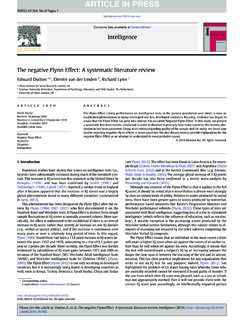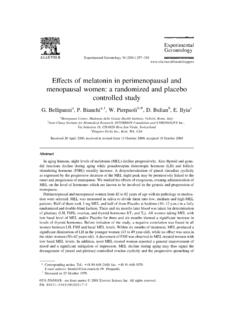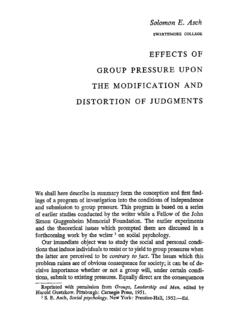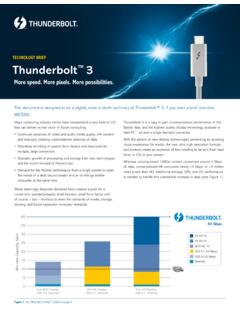Transcription of Effects of Intermittent Fasting on Health, Aging, and Disease
1 The new england journal of medicinen engl j med 381;26 December 26, 20192541 Review ArticleAccording to Weindruch and Sohal in a 1997 article in the Journal, reducing food availability over a lifetime (caloric restriction) has remark-able Effects on aging and the life span in The authors proposed that the health benefits of caloric restriction result from a passive reduction in the production of damaging oxygen free radicals. At the time, it was not generally recognized that because rodents on caloric restriction typically consume their entire daily food allotment within a few hours after its provision, they have a daily Fasting period of up to 20 hours, during which ketogenesis occurs.
2 Since then, hundreds of studies in animals and scores of clinical studies of controlled Intermittent Fasting regimens have been conducted in which metabolic switching from liver-derived glucose to adipose cell derived ketones occurs daily or several days each week. Although the magnitude of the effect of Intermittent Fasting on life-span extension is variable (inf luenced by sex, diet, and genetic factors), studies in mice and nonhuman primates show consistent Effects of caloric restriction on the health span (see the studies listed in Section S3 in the Supplementary Appen-dix, available with the full text of this article at ).
3 Studies in animals and humans have shown that many of the health benefits of Intermittent Fasting are not simply the result of reduced free-radical production or weight Instead, Intermittent Fasting elicits evolutionarily conserved, adaptive cellular responses that are integrated between and within organs in a manner that improves glucose regulation, increases stress resistance, and sup-presses inf lammation. During Fasting , cells activate pathways that enhance intrin-sic defenses against oxidative and metabolic stress and those that remove or repair damaged molecules (Fig.)
4 1).5 During the feeding period, cells engage in tissue-specific processes of growth and plasticity. However, most people consume three meals a day plus snacks, so Intermittent Fasting does not ,6 Preclinical studies consistently show the robust Disease -modifying efficacy of Intermittent Fasting in animal models on a wide range of chronic disorders, in-cluding obesity, diabetes, cardiovascular Disease , cancers, and neurodegenerative brain ,7-10 Periodic f lipping of the metabolic switch not only provides the ketones that are necessary to fuel cells during the Fasting period but also elicits highly orchestrated systemic and cellular responses that carry over into the fed state to bolster mental and physical performance, as well as Disease ,12 Here, we review studies in animals and humans that have shown how intermit-tent Fasting affects general health indicators and slows or reverses aging and Disease processes.
5 First, we describe the most commonly studied Intermittent - Fasting regimens and the metabolic and cellular responses to Intermittent Fasting . We then present and discuss findings from preclinical studies and more recent clinical studies that tested Intermittent - Fasting regimens in healthy persons and in From the Translational Gerontology Branch ( ) and the Laboratory of Neurosci-ences ( ), Intramural Research Pro-gram, National Institute on Aging, National Institutes of Health, and the Department of Neuroscience, Johns Hopkins Univer-sity School of Medicine ( ) both in Baltimore.
6 Address reprint requests to Dr. Mattson at the Department of Neuro-science, Johns Hopkins University School of Medicine, 725 N. Wolfe St., Baltimore, MD 21205, or at mmattso2@ jhmi . Engl J Med 2019;381 : 2019 Massachusetts Medical L. Longo, , EditorEffects of Intermittent Fasting on Health, Aging, and DiseaseRafael de Cabo, , and Mark P. Mattson, The New England Journal of Medicine Downloaded from at UNIVERSITY OF WASHINGTON on December 25, 2019. For personal use only. No other uses without permission. Copyright 2019 Massachusetts Medical Society. All rights reserved. n engl j med 381;26 December 26, 20192542 The new england journal of medicinepatients with metabolic disorders (obesity, insu-lin resistance, hypertension, or a combination of these disorders).
7 Finally, we provide practical information on how Intermittent - Fasting regi-mens can be prescribed and implemented. The practice of long-term Fasting (from many days to weeks) is not discussed here, and we refer inter-ested readers to the European clinical experi-ence with such Fasting Intermittent Fasting and Metabolic SwitchingGlucose and fatty acids are the main sources of energy for cells. After meals, glucose is used for energy, and fat is stored in adipose tissue as triglycerides. During periods of Fasting , triglycer-ides are broken down to fatty acids and glycerol, which are used for energy.
8 The liver converts fatty acids to ketone bodies, which provide a major source of energy for many tissues, espe-cially the brain, during Fasting (Fig. 2). In the fed state, blood levels of ketone bodies are low, and in humans, they rise within 8 to 12 hours after the onset of Fasting , reaching levels as high as 2 to 5 mM by 24 ,15 In rodents, an eleva-tion of plasma ketone levels occurs within 4 to 8 hours after the onset of Fasting , reaching milli-molar levels within 24 The timing of this response gives some indication of the ap-propriate periods for Fasting in Intermittent - Fasting ,3In humans, the three most widely studied Intermittent - Fasting regimens are alternate-day Figure 1.
9 Cellular Responses to Energy Restriction That Integrate Cycles of Feeding and Fasting with energy intake, diet composition, and length of Fasting between meals contribute to oscillations in the ratios of the levels of the bioenergetic sensors nicotin-amide adenine dinucleotide (NAD+) to NADH, ATP to AMP, and acetyl CoA to CoA. These intermediate energy carriers activate downstream proteins that regulate cell function and stress resistance, including transcription factors such as forkhead box Os (FOXOs), peroxisome proliferator activated receptor coactivator 1 (PGC-1 ), and nuclear factor erythroid 2 related factor 2 (NRF2); kinases such as AMP kinase (AMPK); and deacetylases such as sirtuins (SIRTs).
10 Intermittent Fasting triggers neuroendocrine responses and adaptations character-ized by low levels of amino acids, glucose, and insulin. Down-regulation of the insulin insulin-like growth fac-tor 1 (IGF-1) signaling pathway and reduction of circu-lating amino acids repress the activity of mammalian target of rapamycin (mTOR), resulting in inhibition of protein synthesis and stimulation of autophagy. During Fasting , the ratio of AMP to ATP is increased and AMPK is activated, triggering repair and inhibition of anabolic processes. Acetyl coenzyme A (CoA) and NAD+ serve as cofactors for epigenetic modifiers such as SIRTs.
















